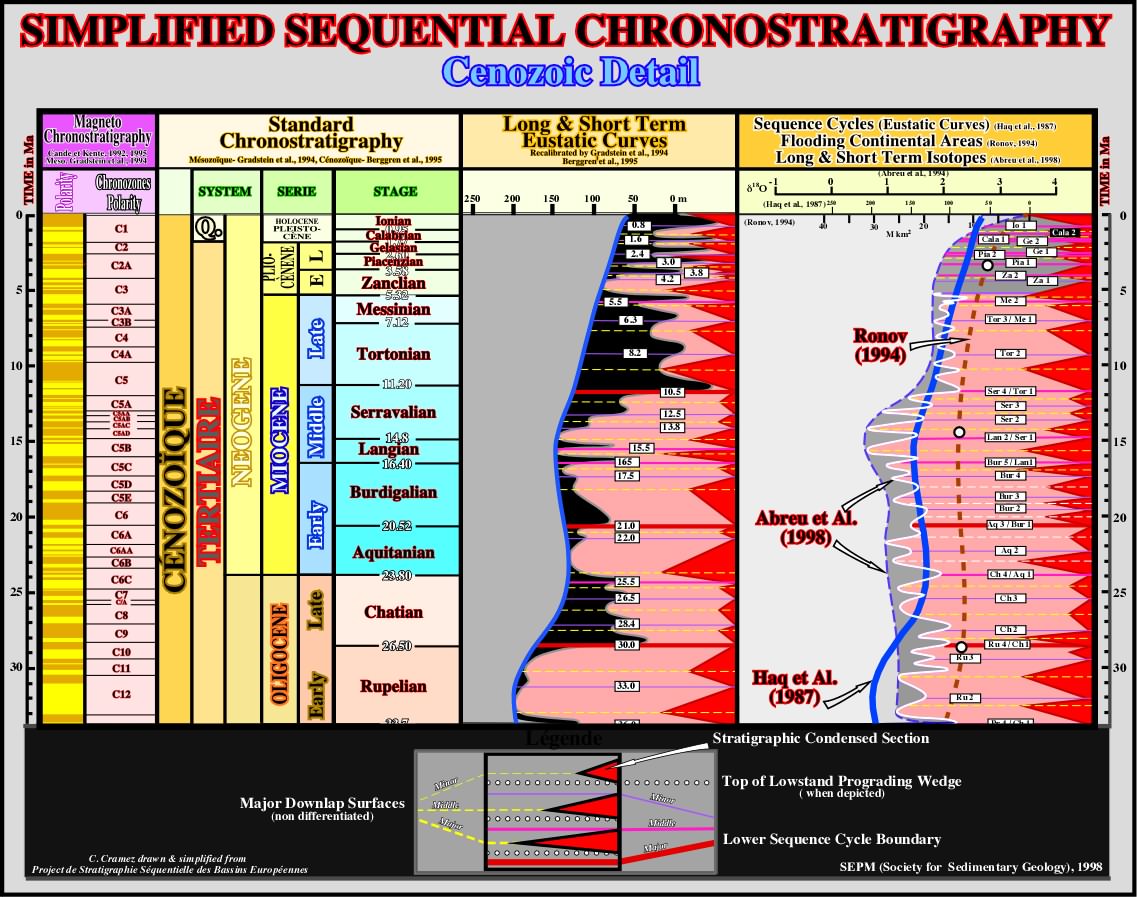

Caveat:
These notes should not be taken as an attempt to write a textbook on Sequential Stratigraphy. They are just an eclectic assemblage of geological models, cross-sections and seismic profiles used during my last workshops on Petroleum Geology. The text is reduced to a minimum. On the figures, as well as, on the geological tentative interpretations of the seismic lines, for confidential reasons, the original lines, which are shown during the short-cours, were replaced by automatic auto-traces made with Canvas software. By the same token the locations and orientations of the auto-traces are roughly indicated. Geological messages are proposed in the captions. The name of the authors of the original figures (diagrams, pictures, maps, etc.) and the name of interpreters of the proposed tentative interpretations are always display (unless our error). If you intend to use some data illustrated here, it is recommended to ask permission before (carloscramez@gmail.com or carlos.cramez@bluewin.ch), particularly if it is not signed by the author of these notes.

This geological tentative interpretation of a seismic line of the USA onshore was performed at a high hierarchic level. The postsalt interval was interpreted in stratigraphic sequence cycles, which were deposited during 3rd order eustatic cycles. Each of these stratigraphic cycles is bounded by unconformities (erosional surfaces). The time-interval between the lower and upper unconformities bounding the stratigraphic cycles ranges between 0.5 and 3 to 5 My (million years). Such a time-interval should not be confounded with the total time-deposition of the sediments forming the stratigraphic cycle (sequence cycle), since the completeness of the different systems tracts composing a sequence cycle is rarely total, that is to say, it is smaller than one. From bottom to top, each sequence cycle (when complete), is composed by : (i) a Lowstand Systems Tract (LST), in purple on this tentative interpretation ; (ii) a Transgressive Systems Tract (TST), in green, and (iii) a Highstand Systems Tract (HST), in orange. Three members can be, often, recognized within Lowstand Systems Tract (LST) : 1- Basin Floor Fan (BFF), at the bottom ; 2- Slope Fan (SF), in the middle, and 3- Lowstand Prograding Wedge (LPW), at the top. In this tentative interpretation, the basin floor fans (BBF) and slope fans (SF) were not deposited or are downdip seaward of this area. A systems tract is a lateral linkage of contemporaneous and genetically related depositional systems, which correspond to an association of a lithology (facies) and a particular fauna. Take note that, by convention, My (millions years) means an internal of time, while Ma, as SB. 30 Ma, means an age, in this particular case, the age of unconformity limiting two stratigraphic sequence cycle. If we have problems understanding these comments this short course is going to help you.

For the Mesozoic and Cenozoic, the sequential chronostratigraphy used in this short-course is the one proposed, for European Basin, in 1998, by Jan Hardenbol, Jacques Thierry, Martin B. Farley, Thierry Jacquin, Pierre-Charles de Graciansky and Peter R. Vail (SEPM Special Publication 60) from which a simplified detail of Cenozoic is illustrated above. For the Paleozoic and Pre-Paleozoic the used time scale is the one proposed by Harland et al., in 1982. In volume IV, Chapter 6, you will find the sequential chronostratigraphic charts at a larger scale. Note that in absence of wildcats, the seismic calibration of the geological tentative interpretations of the seismic lines, used in this short-course, is, often, based on the Neogene Global Stratigraphic Signature proposed of Peter Vail and his students (1991).
Contents:
Introduction
A) Geophysical Surveying
B) Potential Methods
C) Interpretation Difficulties
C.1) Time Sections versus Depth Sections
C.2) Unmigrated versus Migrated Profiles
C.3) Lateral arrivals
C.4) Multiples
C.5) Diffractions
C.6) Reflected Refractions
C.7) Static Corrections
D) Geological Models and Seismic Responses
D.1) Monoclines
D.2) Normal Faults
D.3) Reverse Faults
D.4) Shale Domes
D.5) Salt Domes
D.6) Reefs
D.7) Canyons
D.8) Freezing
D.9) SynformsDriving Concepts
1) Time Stratigraphy
2) Time Line in Rocks
3) Systems Tracts & Facies
Depositional Model
Stratigraphic Concepts
Stratigraphic Boundaries
Geometrical Relationships
1) Onlap
2) Downlap
3) Toplap
4) Truncation
Discontinuity Surfaces
a) Unconformities
b) Depositional Hiatus
External Forms & Internal Configurations
1) Filling Patterns
2) Progradational Patterns
Significance of Geometrical Configurations
Diachronous SurfacesSequential Stratigraphy
Sequential Stratigraphy Analysis
Sequential versus Genetical Stratigraphy
Hierarchical Level of Interpretation
Controlling Parameters of Sequential Stratigraphy
A) Eustasy or Eustatism
A.1- Eustasy Metaphor
A.2- Geoid
A.3- Geoid Changes
B) Eustatic Cycles
C) Climate (Glaciations)
C.1- Origin of the Ice Ages
D) Subsidence & Accommodation
E) Terrigeneous Influx
Tectonic versus Eustasy
Eustatic and Stratigraphic Cycles
a) Continental Encroachment Cycle
b) Continental Encroachment Sub-cycle
c) Sequence Cycle
d) Parasequence Cycle
Depositional Models
Marco Polo Software
1) Sand-Shale Model
1.1) Evolution of the Sand-Shale Model
1.2) Model Variables Impact
2) Carbonate Model
Exercises
a) Depositional Costal Break
b) Paleowater Depth
c) Accommodation
d) BaylineSystems Tracts
1) Lowstand Systems Tract (LST)
a) Geological Settings
a.1- Deepwater Setting
a.2- Ramp Setting
a.3-Growth Fault Setting
b) Lower Member: Basin Floor Fan (BFF)
c) Middle Member: Slope Fan (SF)
d) Upper Member: Lowstand Prograding Wedge (LPW)
e) Turbidite Deposits Associated with LPW
f) Submarine Canyon Fill (SCF) & Incised Valley fill (IVF)
2) Transgressive Systems Tract (TST)
3) Highstand Systems Tract (HST)
4) Neogene Global Stratigraphic Signature
5) Recapitulation
5.1- Sequence Cycle Model
- Systems Tracts
- Relative Sea Level
5.2- Sea Level Responses to Orbital Perturbations and Subsidence
5.3- Major Transgressive - Regressive Cycles
5.4- Available Space & Sediment Supply
5.5- Paleobathymetry, Faunal Peaks, Depositional Systems, Lithofacies, Electric Log Patterns, etc.
5.6- Sea Level and Systems Tracts
6) Meso - Cenozoic Cycle Chart ; 7) Paleozoic Cycle Chart ; 8) Time Scale and Events ; 9) Eustasy and Orogenies
10) Bibliography